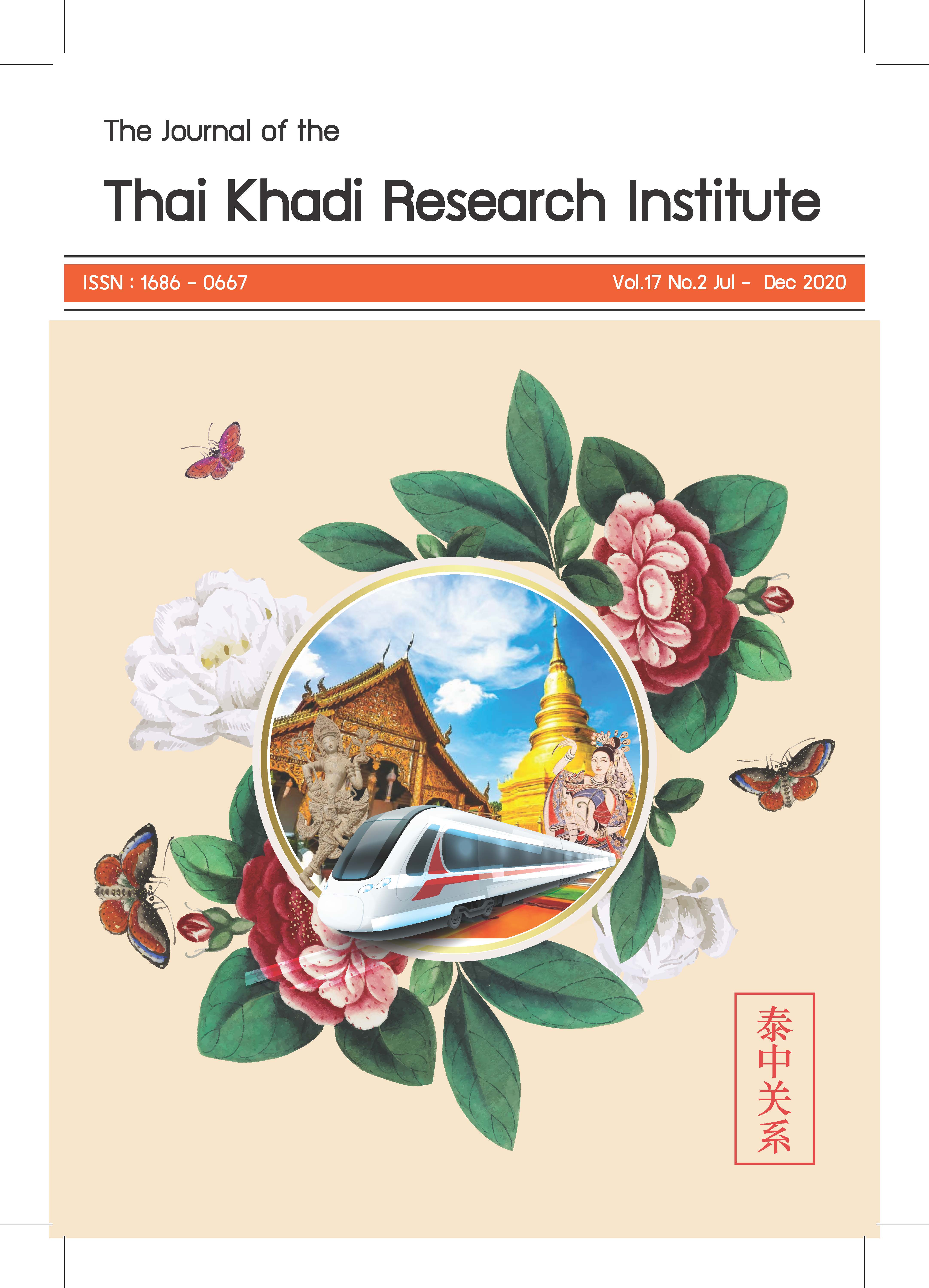ความสำคัญของ “จีน” หรือ “สาธารณรัฐประชาชนจีน” ต่อไทยในปัจจุบัน ทวีความสำคัญขึ้นอย่างไม่อาจปฏิเสธได้ ทั้งในแง่นโยบายระหว่างประเทศ หรือการที่ไทยจัดวางความสำคัญของจีนในฐานะ “มหาอำนาจที่สำคัญที่สุด” อันเนื่องมาจากสถานการณ์ความเปลี่ยนแปลงภายในของไทยเอง พร้อมกันนี้ ภายใต้ความสัมพันธ์ที่แนบแน่นขึ้นดังกล่าว องค์ความรู้ว่าด้วยเรื่อง “จีนศึกษา” ในไทย ตลอดจนประเด็นความสัมพันธ์ไทย - จีน นับได้ว่ามีพลวัตที่ขยับปรับเปลี่ยนไปอย่างพลิกแพลง ลุ่มลึก และหลากหลายขึ้น ดังเนื้อหาในวารสารไทยคดีศึกษาปีที่ 17 ฉบับที่ 2 นี้ ที่มีบทความเกี่ยวเนื่องกับ “จีน” ในแง่มุมต่าง ๆ ถึง 3 บทความ
บทความแรก การสร้างความรู้ความสัมพันธ์ไทย - จีน และการประยุกต์ใช้แนวพินิจพรมแดนกับการศึกษาความสัมพันธ์ไทย - จีน ผ่านการส่องสำรวจชีวิต เจียแยนจอง ของ สิทธิเทพ เอกสิทธิพงษ์ ที่เป็นการทดลองนำเสนอแนวพินิจพรมแดน (Frontier Approach) ในการศึกษาความสัมพันธ์ทางการทูตไทย - จีน ผ่านการฉายภาพชีวิตและบทบาททางวิชาการของ เจียแยนจอง (ยรรยง จิระนคร) ทั้งนี้ นับตั้งแต่ทศวรรษ 2470 บรรดานักวิชาการจีนพยายามผลิตงานวิชาการต่อต้านประวัติศาสตร์ชาติไทยฉบับอัลไต - น่านเจ้า ด้วยต้องการเน้นย้ำว่าน่านเจ้าไม่ใช่อาณาจักรของกลุ่มคนที่ใช้ภาษาไท ซึ่งเชื่อกันว่าเป็นบรรพบุรุษของคนไทย เจียแยนจอง ผู้มีพื้นเพของการเป็นจีนโพ้นทะเลผู้หวนคืนสู่มาตุภูมิจากประเทศไทย นับเป็นหนึ่งในทรัพยากรสำคัญสำหรับพรรคคอมมิวนิสต์ในการบูรณาการคนไตเข้ามาเป็นส่วนหนึ่งของคนชาติจีน ด้วยสถานะบทบาทนักวิชาการด้านไทศึกษาที่ชี้ชวนให้เห็นว่าสังคมวัฒนธรรมไทมีบ่อเกิดจากการรับวัฒนธรรมจีนโบราณ ควรกล่าวด้วยว่า การสร้างความรู้ของเจียตอบสนองทั้งความต้องการของจีนและไทย กล่าวคือ สำหรับจีนการเน้นอิทธิพลอารยธรรมจีนต่อคนไตสนับสนุนการอ้างความยึดโยงระหว่างคนไตกับชาติจีนอย่างน้อยในเชิงวัฒนธรรม ขณะที่สำหรับไทย การอ้างอิงถึงการรับอารยธรรมจีนของคนไต ได้ช่วยเสริมพลังการนิยาม “การนิยามชาติไทย” ภายใต้แนวทางการผสมผสาน (Assimilation) ทางเชื้อชาติ ที่หมายรวมคนจีนเข้ามาเป็นส่วนหนึ่งใน “ความเป็นไทย” อันเป็นการทำลายมายาคติสารัตถะการมีอยู่ของความเป็นไทยที่แท้ ซึ่งเป็นทัศนะทางวิชาการที่ล้าหลังลงไปอย่างมีนัยสำคัญ
แม้ความสัมพันธ์ทางการทูตระหว่างไทยกับสาธารณรัฐประชาชนจีนจะเกิดขึ้นอย่างเป็นทางการนับตั้งแต่ พ.ศ. 2518 ทว่า ความสำคัญของจีนต่อไทยนั้นมีมากขึ้นอย่างมีนัยสำคัญตั้งทศวรรษ 2540 และยิ่งผูกพันอย่างลึกซึ้ง ภายหลัง พ.ศ. 2557 ทั้งนี้ เป็นที่รับรู้ว่าไทยเริ่มเคลื่อนย้ายตนเองเข้าไปในเขตอิทธิพลทางภูมิรัฐศาสตร์ของจีนและถอยห่างเขตอิทธิพลทางภูมิรัฐศาสตร์ของสหรัฐฯ ภายใต้กระบวนการ “หันขวา - หาจีน” นับตั้งแต่ยุคของนายกรัฐมนตรีทักษิณ ชินวัตร (พ.ศ. 2544 - 2549) โดยนโยบายดังกล่าวนับเป็นฉันทามติแห่งชาติทางสถาบันและวัฒนธรรมที่ข้ามพ้นเส้นแบ่งความขัดแย้งทางการเมืองภายในของชนชั้นนำ หากแต่ภายใต้ยุคสมัย คสช. กระบวนการ “หันขวา - หาจีน” ยิ่งเดินหน้าในอัตราเร่งอย่างหนักหน่วง สาระในบทความ โครงการรถไฟความเร็วสูงไทย - จีน: โอกาสของการพัฒนาภาคตะวันออกเฉียงเหนือ ของ หงษ์ฟ้า ทรัพย์บุญเรือง และ จินตวัฒน์ ศิริรัตน์ คือหนึ่งในข้อยืนยันสถานการณ์ในบริบทรัฐบาล คสช. (พ.ศ. 2557 - 2562) ด้วยเป็นการศึกษาที่ชี้ให้เห็นว่า แม้โครงการรถไฟความเร็วสูงไทย - จีน ที่ตัดผ่านภาคอีสานเชื่อมต่อชายแดนไทย - ลาว ที่จังหวัดหนองคาย จะสุ่มเสี่ยงกับภาวะความไม่คุ้มทุนในแง่อัตราผลตอบแทนทางเศรษฐกิจ แต่ความสัมพันธ์ในแง่การรักษาความสัมพันธ์ฉันมิตรกับจีนหลังจากถูกชาติตะวันตกคว่ำบาตรตั้งแต่หลังรัฐประหาร พ.ศ. 2557 และการพัฒนาภูมิภาคตามเป้าหมายของยุทธศาสตร์ชาติ คือ ปัจจัยสำคัญที่อธิบายการดำรงอยู่ของเมกะโปรเจ็กต์ที่ดูจะไม่คุ้มทุนดังกล่าว
บทความเรื่อง การปรับเปลี่ยนความสัมพันธ์ทางสังคมของชาวจีนฮกจิว อำเภอนาบอน จังหวัดนครศรีธรรมราช พ.ศ. 2468 - ปัจจุบัน ของ สิรีธร ถาวรวงศา เป็นอีกหนึ่งในกรณีศึกษาที่แสดงให้เห็นถึงการปรับเปลี่ยนสายสัมพันธ์ ตลอดจนอัตลักษณ์ของกลุ่ม “จีนฮกจิว” หนึ่งในทุนจีนปักษ์ใต้ที่ย้ายถิ่นฐานมาจากดินแดนมลายาของอังกฤษ เพื่อมาตั้งรกรากบุกเบิกการประกอบอาชีพทำสวนยางพาราในดินแดนปักษ์ใต้มากว่าศตวรรษ ทั้งนี้ ภายใต้ระบบการผลิตที่สัมพันธ์กับการค้าเชิงพาณิชย์ ระบบทุนนิยม กระทั่งความสัมพันธ์กับรัฐไทยที่แนบแน่นมากขึ้นเป็นลำดับ ส่งผลให้ความยึดโยงในสังคมจีนฮกจิวที่สัมพันธ์กับอาชีพการทำสวนยางพารานั้นเปลี่ยนไป เช่น การเกิดชนชั้นของจีนฮกจิวรวย - ปานกลาง - จน ที่แบ่งแยกบทบาทหน้าที่กันชัดเจนขึ้น การแปรเปลี่ยนความสัมพันธ์จากสายสัมพันธ์แบบ “ตั่วเฮีย” - “ลูกน้อง” ไปสู่ “นายจ้าง” - “ลูกจ้าง” การหายไปของระบบกงสี ไปจนถึงความสามารถเชื่อมโยงกับอัตลักษณ์ความเป็นไทยที่ทำให้ความเข้มข้นในการรวมกลุ่มทางสังคมแบบเดิมลดลง กระนั้นก็ตาม แม้ความสัมพันธ์ทางสังคมแบบเดิมจะหลงเหลือเพียงมิติขององค์กรทางสังคมวัฒนธรรม หากแต่กลุ่มจีนฮกจิวในปัจจุบันก็สามารถหยิบใช้เงื่อนไขนี้ ในการเปิดรับความสัมพันธ์ทางการค้าและการลงทุนในกิจการด้านยางพารากับสาธารณรัฐประชาชนจีน ในขณะที่จีนแผ่นดินใหญ่ ก็เล็งเห็นถึงการใช้สายสัมพันธ์ดังกล่าวเพื่อเชื่อมต่อกับกลุ่มทุนจีนโพ้นทะเลในภูมิภาค ต่าง ๆ
นอกจากบทความที่เกี่ยวข้องกับ “จีน” ดังที่กล่าวมา วารสารไทยคดีศึกษาฉบับนี้ ยังมีบทความ ล้านนาที่เพิ่งสร้าง ประวัติศาสตร์สังคมของดินแดนลุ่มน้ำเจ้าพระยาตอนบน (พ.ศ. 2475 - 2557) ของ ภิญญพันธุ์ พจนะลาวัณย์ ที่เป็นการมองประวัติศาสตร์ภาพกว้างและพลิกกลับการรับรู้เกี่ยวกับดินแดนภาคเหนือของไทย ผ่านแว่น “อาณานิคมภายใน” ผู้เขียนชี้ให้เห็นว่า ความเปลี่ยนแปลงราว 8 ทศวรรษที่ผ่านมาของภาคเหนือสัมพันธ์กับการถูกกำหนดจากส่วนกลางนับตั้งแต่ กำเนิด “ภาคเหนือ” หลังมณฑลพายัพสลายตัว การก่อรูปของภาคเหนือภายหลังสงครามโลกครั้งที่ 2 ภาคเหนือภายใต้ภาวะ “อาณานิคมแบบสงครามเย็น” กระบวนการกลายเป็น “ล้านนา” กับภาวะรวมศูนย์ของเมืองเชียงใหม่ ทั้งหมดนี้คือการทำให้ประวัติศาสตร์ดินแดนแห่งนี้ และ อัตลักษณ์ของล้านนา คือ ความนอบน้อม รุ่มรวยในวัฒนธรรม ไม่แข็งขืนและชวนฝัน กระนั้นก็ตาม ภายใต้บริบทขยายตัวของทัศนะเสรีนิยมประชาธิปไตย ความขัดแย้งทางการเมืองระหว่างสีเสื้อ แนวคิดภูมิภาคนิยม ฯลฯ เงื่อนไขเหล่านี้มีผลต่อการเปลี่ยนแปรสำนึกทางประวัติศาสตร์ที่ส่งผลให้เกิดอัตลักษณ์ความเป็นล้านนาอีกแบบหนึ่งที่แข็งขืน แข็งกร้าว หาใช่ล้านนาแบบที่รัฐไทยคุ้นเคยเช่นแต่ก่อน
ท้ายสุดคือ บทความ มันนิ “ซาไก”: ภาพตัวแทน ชาติพันธุ์ และความเป็น ชายขอบ ของ อภิชญา แก้วอุทัย ที่ชี้ให้เห็นถึงกระบวนการถูกทำให้เป็นชายขอบของชาว “มันนิ” หรือ “ซาไก” ผ่านการนำเสนอในวาทกรรมของสื่อ 2 ประเภทคือ หนังสือพิมพ์รายวัน และสื่อประเภทสารคดี ทั้งนี้ ภาพแทนของ มันนิ “ซาไก” ในวาทกรรมหนังสือพิมพ์รายวันเกือบทั้งหมดคือภาพตัวแทนในด้านลบ เช่น ความเป็นชนกลุ่มน้อยที่แตกต่างจากชนกลุ่มใหญ่ มีความเป็นอยู่ที่ล้าสมัย ต้องได้รับความช่วยเหลือดูแล ต้องได้รับการพัฒนา ขณะที่วาทกรรมที่ปรากฏในสารคดีมีภาพด้านบวกอยู่ด้วย เช่น วิถีชีวิตของซาไกที่ผูกพันกับผืนป่า เป็นต้น อย่างไรก็ตาม สื่อทั้ง 2 ประเภท ก็ยังคงให้ภาพ วาทกรรมในด้านลบที่เป็นการตอกย้ำว่าพวกเขาเป็นอีกชนชั้นหนึ่งที่ไม่เคยเท่าเทียมกับชนส่วนใหญ่ของประเทศ ต่อประเด็นนี้ “มันนิ” หรือ “ซาไก” จึงทำให้เป็นชายขอบทั้งในแง่การถูกกีดกัน - จำกัดวง - ทำให้อ่อนแอ อยู่ร่ำไป
วารสารไทยคดีศึกษาฉบับนี้ยังมี บทวิจารณ์หนังสือ คู่มือนำชม ศิลปกรรมโบราณในล้านนา ของ ศาสตราจารย์ ดร.ศักดิ์ชัย สายสิงห์ วิจารณ์โดย มนวัธน์ พรหมรัตน์ ได้ตั้งข้อสังเกตเบื้องต้นบางประการด้วยวิธีวิทยาที่แตกต่างไปจากวิธีด้านประวัติศาสตร์ศิลปะของผู้เขียนหนังสือ ที่มุ่งเน้นในการวิเคราะห์หลักฐานงานศิลปกรรมอย่างลุ่มลึก ซึ่งทำให้เห็นภาพพัฒนาการและเอกลักษณ์ของงานศิลปกรรมล้านนาในแต่ละพื้นที่ได้เป็นอย่างดี นอกจากนี้ เนื้อหายังมีข่าวกิจกรรมวิชาการและศิลปวัฒนธรรมที่สถาบันไทยคดีศึกษาจัดขึ้นในช่วงเดือน กรกฎาคม - ธันวาคม พ.ศ. 2563 ซึ่งได้รวบรวมและสรุปสาระสำคัญของกิจกรรมเหล่านี้ไว้ด้วย
ทั้งนี้ กองบรรณาธิการหวังว่า วารสารไทยคดีศึกษาจะเป็นเวทีและสื่อกลางในการเผยแพร่แลกเปลี่ยนองค์ความรู้ด้าน “ไทยศึกษา” ที่สามารถตอบโจทย์ในด้านวิชาการและเป็นคุณูปการต่อสังคม อีกทั้งเป็นวารสารทางวิชาการที่ผู้สนใจให้การสนับสนุนต่อไป
เผยแพร่แล้ว: 2020-12-17


